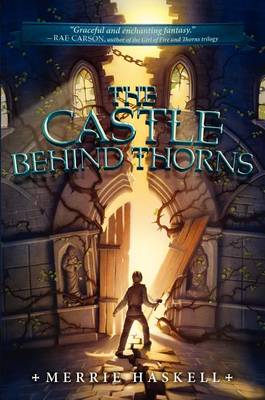Reviewed by Briana @ Pages Unbound on
The book opens with Sand’s awakening in the Sundered Castle, the home the local Countess’s family mysteriously abandoned after everything inside was torn in two. Unable to get through the malevolent thorn bush surrounding the castle and back to his home, Sand sets to work mending things. Unknowingly, he even “mends” Perrotte, the castle’s heir—who has been dead for twenty-five years.
Readers immediately witness Sand’s ingenuity and perseverance, as he undauntedly takes on the task of repairing an entire castle. Unfortunately, the beginning of The Castle Behind Thorns does not get more interesting than that. The first half of the book is heavily filled with scenes of Sand’s fixing things. Once Perrotte joins him, the book expands into scenes of both of them fixing things. Frankly, the first part of this book is slow.
Some of the details add a little dimension and atmosphere to the early chapters, however. Perrotte haltingly reflects on what it was like to be dead, which is both intriguing and just a bit dark. Readers also get glimpses into the religious aspects of the story and the saints that the characters believe are influencing their lives and helping them mend the castle.
The pace picks up more completely about halfway through, as the plot reaches several crises/climaxes. Sand and Perrotte finally find their chance to get past the magic thorns, but it turns out that staying inside might actually be the safer option for both. The book goes in all sorts of great directions at this point, pulling on miracles, diplomacy, family dynamics, and more. Readers get both excitement and some meaningful reflections on life and family.
On one hand, The Castle Behind Thorns has a promising premise: children trapped in a magic castle! On the other hand, it becomes apparent that, well, two children alone in a castle do not really have that many adventures (particularly if the castle is not dynamically magical like, say, the one in Jessica Day George’s Tuesdays at the Castle). Furthermore, these children are generally likable and resourceful human beings, relatively at peace with their fate, so there are not even any dark psychological directions to go with the plot of their being trapped alone—maybe forever—in a castle. (Or maybe we’re just not doing that because this is middle grade and dark psychological thrillers do not really have a market in this category.)
Once the book begins gathering steam, and readers can focus on something more than their desire for something interesting to happen, it becomes more apparently that The Castle Behind Thorns does feature realistic characters, meaningful reflections on death and the purpose of life, and explorations of what makes solid relationships. This is not my favorite fairy tale retelling, despite its obvious ingenuity in playing with the plot of “Sleeping Beauty,” but I think avid fans of fairy tale retellings will find something to like about it anyway.
Reading updates
- Started reading
- 15 June, 2014: Finished reading
- 15 June, 2014: Reviewed
